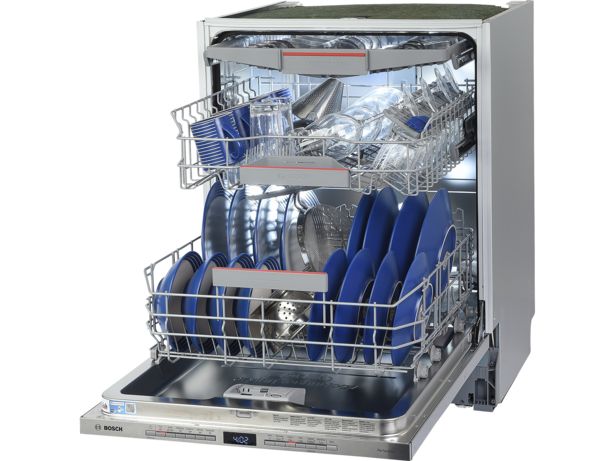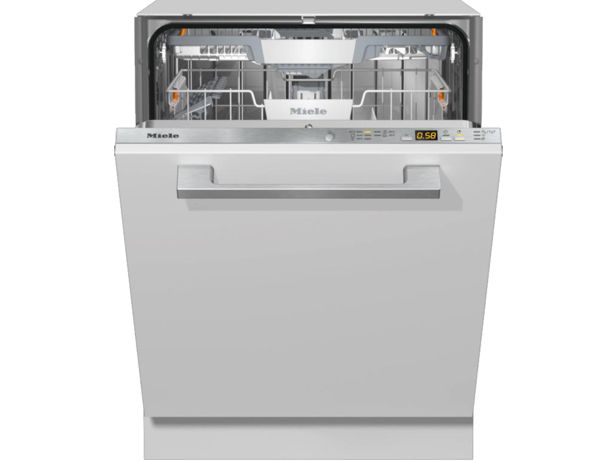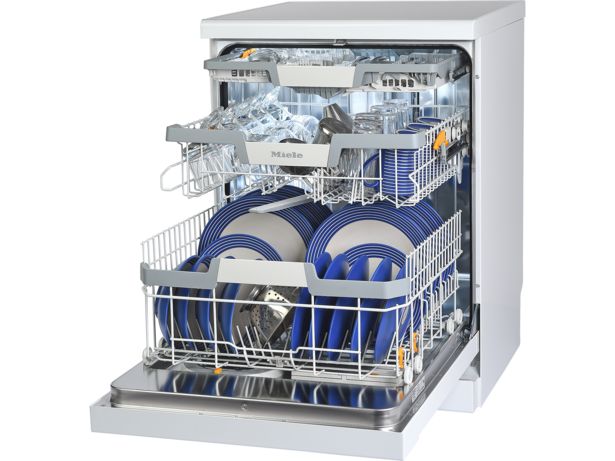Dishwasher salt and rinse aid explained

In this article
- How to use and where to put dishwasher salt
- How to use rinse aid
- What does dishwasher salt do and why do dishwashers need it?
- What does rinse aid do?
- Dishwasher salt brands compared
- Where to buy dishwasher salt and rinse aid
- Dishwasher salt alternatives?
- Do I need dishwasher salt in soft water area?
To clean well, dishwashers need very soft water. This is where dishwasher salt comes in.
When it comes to ensuring your plates, cutlery and plastic containers come out bone dry, rinse aid is the key.
Read on to discover how to use them, and which dishwasher salt and rinse aid brands to buy.
In the market for a new dishwasher? Our dishwasher reviews can help you find the right model for your household.
How to use and where to put dishwasher salt
Your dishwasher's salt compartment is normally at the bottom of the machine, near the filter.
You'll need to pull out the lower rack to access it, and you should have a small funnel that came with your dishwasher to help make sure all the salt goes in the hole.
Only fill up the salt to the water level inside the salt compartment. The amount you put in depends on your dishwasher, so there’s no precise measurement for this process.

To find out how hard the water in your home is, consult your water supplier – you can usually find the information online. You'll be able to find the concentration of calcium and magnesium ions, usually in millimole per litre (mmol/l).
Then consult your dishwasher’s manual to find out which setting will work best.
Most dishwashers also now have a salt refill light. If your dishwasher doesn’t have indicator lights, it’s a good idea to refill the salt about once per month.
And only put salt into the softener unit. The salt you pour in the softener unit never actually touches your dishes; it just stays in the unit itself. If you leave loose salt in the dishwasher, not only will it not work properly, but it may also give you slightly dirty (or salty) dishes.
Never put salt into other spots marked for normal detergent, dishwasher cleaner or rinse aid, as this could easily break your appliance.
How to use rinse aid
The rinse aid compartment is usually right next to the detergent compartment.
Depending on how many washes you do you might have to fill up the rinse aid every few weeks. When doing so it can sometimes have a maximum fill line, which you should not go over.
If you're using rinse aid but are still not happy with your dishwasher's drying you might have the option to turn up the rinse aid setting. This is often just a dial under the rinse aid lid that you can twist to a higher setting.
Be inspired to make home improvements. Sign up for our Home newsletter – it's free monthly
What does dishwasher salt do and why do dishwashers need it?

- Dishwasher detergent works best in soft water, so salt can help you get better cleaning.
- Hard water can cause glasses to become cloudy over time, as well as clog up the insides of your dishwasher with limescale.
Dishwasher salt is different from table salt in that it is pure, 100% NaCl, with no anti-caking agents.
It needs to be this because the sodium in dishwasher salt combines with resin balls in your dishwasher’s workings to absorb the hardness. The resin balls have a negative atomic charge and the dishwasher salt has a positive atomic charge.
The calcium and magnesium swap with the sodium ions, removing the ‘hardness’ and softening the water. So any anti-caking agents or magnesium salts will just defeat the purpose of removing magnesium.
When the resin balls’ sodium stores are exhausted, adding dishwasher salt resets them, so they can absorb more.
What does rinse aid do?
Rinse aid, as the name suggests, will help water rinse off of your dishes and glasses.
It does this by reducing the surface tension of water, meaning it sticks to surfaces less easily and can drain and evaporate away. As such it also helps prevent water marks, to help your glasses come out sparkling and crystal clear.
Rinse aid is key if you want great drying results, although not as fundamental as dishwasher salt is for general upkeep.
Dishwasher salt brands compared

If you look at the ingredients it will just say ‘salt’. So how you can tell which is better?
On a box of Finish dishwasher salt you’ll see ‘100% better protection’, but if you read further you’ll see this isn’t compared to other dishwasher salts; it’s only compared to not using salt at all.
In reality, they should all be the same. All of them will be 100% salt, with no added anti-caking agents.
The only difference could be in the size of the granules or the packaging. Some could come in a recyclable cardboard box, which is more sustainable than a plastic bag.
Where to buy dishwasher salt and rinse aid
You can find dishwasher salt and rinse aid at most supermarkets.
- Asda carries a handful of options for dishwasher salts starting from £1.99 for 2kg, and rinse aids starting from £1.20 for 500ml. They include options from Crystale, Finish, and Asda's own-brand.
- Lidl only stocks their own-brand dishwasher salt, which at the time of writing costs £1.99 for 2kg.
- Sainsbury's has a wider selection of dishwasher salt and rinse aids than other supermarkets, with options ranging from Finish, Crystale, Ecover, and Sainsbury's own-brand. Dishwasher salt starts from £1.50 for 1kg, and rinse aid starts from £1.90 for 400ml.
- Tesco offers dishwasher salts and rinse aid from Finish and their own-brand. Salts start from £3 for 3kg, and rinse aids starts from £1.90 for 400ml.
Not sure which supermarket to buy from? See our round-up of the best and worst supermarkets
Dishwasher salt alternatives?

It needs to be 100% NaCl, and cooking salts often have anti-caking agents to stop them from clumping together.
If the salt you use doesn't have anti-caking agents, such as calcium carbonate or magnesium carbonate, then you can use it. Although there would be little benefit as it would likely be more expensive than regular dishwasher salt.
Don't use dishwasher salt for cooking, either. It doesn't have the same food and health safety regulations on it, so could contain trace amounts of toxins.
Do I need dishwasher salt in soft water area?
It’s a good idea when your dishwasher is new, or if you’ve never topped up the salt, to do so.
You can adjust the water hardness setting in your dishwasher to be suitable for soft water.
You’re unlikely to have to top up the salt often, if ever, but it is a good failsafe in any case to avoid cloudy glasses.
Do you need dishwasher salt if you use all-in-one tablets?

Dishwasher salt problems
Is there too much salt in my dishwasher?
Whenever you're topping up the salt in your dishwasher you're aiming to make a saltwater brine, so you don't want to fill it up to the point that the water inside is overflowing.
If you've done this, then rinsing it with water can help make sure the softener doesn't get clogged with salt.
Why is the dishwasher salt reservoir full of water?
After the first time you use it, your softener unit should always have a bit of water in it. You won’t need to refill it.
Why does the dishwasher keep asking for salt?
You could have to refill the salt every month if you live in a hard water area and run your dishwasher often.
If you think you're having to refill it too often then you could try lowering the water hardness setting on your dishwasher.
Instructions on how to do this should be in the manual.



